Als doodgraver heb ik zo mijn pleziertjes.
Soms neem ik eigenhandig de beitel ter hand en kap een opschrift in een grafsteen.
Ik deed dat met die van de Belgische illustrator Benoît van Innis die niet minder dan 35 bijdragen mocht leveren aan The New Yorker. Niet minder dan 35. Maar ook niet meer.
Dat hij nooit is doorgebroken als echte ‘artiest’ is hem altijd dwars blijven zitten. Geen nood, hier wordt hij in eer hersteld. Hij krijgt een mooier plekje dan veel ‘echte’ artiesten: op dat heuveltje, net een beetje hoger, lommerrijk omgeven door treurberken, waar ook Paul Ibou ligt.
Op zijn steen kap ik:
‘Ik struikel wankel door de harde vaste eeuwigheid’ van Federico García Lorca. Benoît hield daarvan.
Ik moet aan Roland Topor denken als ik Benoît zie.
Er is een promofilmpje voor Instant Light, een coronatentoonstelling die Benoît hield in Mechelen met tekeningen die hij dagelijks maakte in die surreële periode.
Op de achtergrond leest Ann Meskens mooie woorden uit Mijn laatste snik (1982) van Luis Buñuel.
Ann leest mooi voor. Ook de tekst doet mij aan Topor denken, aan Mémoires d’un vieux con (1975) bijvoorbeeld.
Iedereen hield van Benoît.
Rust zacht Benoît.


